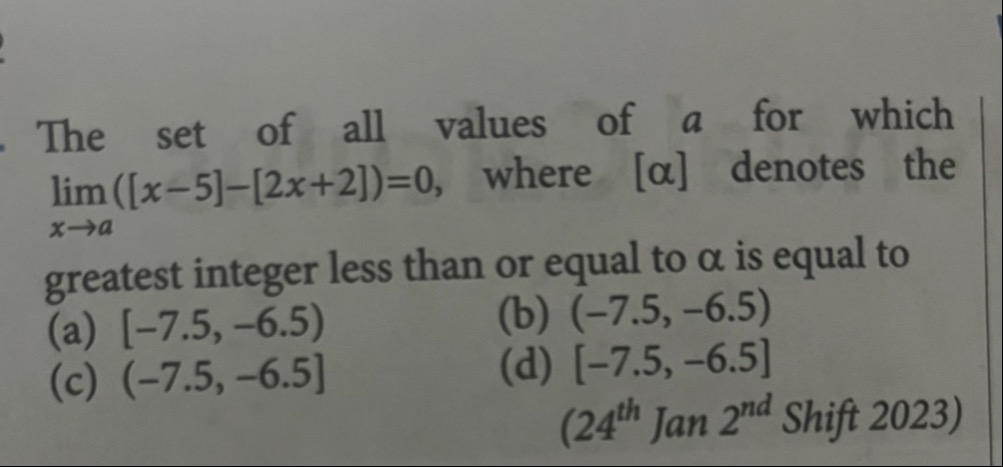Question
Question: The set of all values of $a$ for which $\lim_{x\to a}([\![x-5]\!]-[\![2x+2]\!])=0$, where $[\alpha]...
The set of all values of a for which
limx→a([[x−5]]−[[2x+2]])=0, where [α] denotes the greatest integer less than or equal to α is equal to

[-7.5, -6.5)
(-7.5, -6.5)
(-7.5, -6.5]
[-7.5, -6.5]
(-7.5, -6.5)
Solution
Let f(x)=[[x−5]]−[[2x+2]]. We are looking for the set of all values of a for which limx→af(x)=0. For the limit to exist and be equal to 0, the left-hand limit (LHL) and the right-hand limit (RHL) must both exist and be equal to 0.
Let g(x)=[[x−5]] and h(x)=[[2x+2]]. The limits of g(x) and h(x) as x→a depend on whether a−5 and 2a+2 are integers.
limx→a−[[x−5]]={[[a−5]][[a−5]]−1if a−5∈/Zif a−5∈Z limx→a+[[x−5]]=[[a−5]]
limx→a−[[2x+2]]={[[2a+2]][[2a+2]]−1if 2a+2∈/Zif 2a+2∈Z limx→a+[[2x+2]]=[[2a+2]]
Let I1=1 if a−5∈Z and I1=0 if a−5∈/Z. Let I2=1 if 2a+2∈Z and I2=0 if 2a+2∈/Z.
LHL = limx→a−g(x)−limx→a−h(x)=([[a−5]]−I1)−([[2a+2]]−I2)=[[a−5]]−[[2a+2]]−I1+I2. RHL = limx→a+g(x)−limx→a+h(x)=[[a−5]]−[[2a+2]].
For the limit to exist and be 0, we must have LHL = RHL = 0. RHL = [[a−5]]−[[2a+2]]=0⟹[[a−5]]=[[2a+2]]. Let k=[[a−5]]=[[2a+2]] for some integer k.
If RHL = 0, then LHL = 0−I1+I2. For LHL = 0, we need I1=I2. This means that either both a−5 and 2a+2 are integers (I1=1,I2=1) or neither is an integer (I1=0,I2=0).
Condition 1: [[a−5]]=[[2a+2]]. Let this common integer value be k. k≤a−5<k+1⟹k+5≤a<k+6. k≤2a+2<k+1⟹k−2≤2a<k−1⟹2k−2≤a<2k−1. So, a must be in the intersection of [k+5,k+6) and [2k−2,2k−1). Intersection interval: [max(k+5,2k−2),min(k+6,2k−1)). For the intersection to be non-empty, max(k+5,2k−2)<min(k+6,2k−1). This requires k+5<2k−1 and 2k−2<k+6. 2k+10<k−1⟹k<−11. k−2<2k+12⟹−14<k. So, −14<k<−11. The possible integer values for k are −13 and −12.
Condition 2: I1=I2. Case 2a: I1=0 and I2=0. a−5∈/Z and 2a+2∈/Z. This means a∈/Z and a∈/Z/2 (half-integers). We need to find a in the intersection interval for k=−13 and k=−12 such that a is neither an integer nor a half-integer. For k=−13: [−13+5,−13+6)∩[2−13−2,2−13−1)=[−8,−7)∩[−7.5,−7)=[−7.5,−7). For a∈[−7.5,−7): a−5∈[−12.5,−12). a−5 is an integer only if a−5=−13 or a−5=−12, i.e., a=−8 or a=−7. Neither is in [−7.5,−7). So a−5∈/Z. 2a+2∈[−13,−12). 2a+2 is an integer only if 2a+2=−13 or 2a+2=−12, i.e., a=−7.5 or a=−7. If a=−7.5, 2a+2=−13∈Z. So a=−7.5 is excluded from this case. If a=−7, a is an integer, so excluded from this case. For a∈(−7.5,−7), a is not an integer and 2a+2∈/Z. Also a−5∈/Z. So a∈(−7.5,−7) satisfies I1=0,I2=0.
For k=−12: [−12+5,−12+6)∩[2−12−2,2−12−1)=[−7,−6)∩[−7,−6.5)=[−7,−6.5). For a∈[−7,−6.5): a−5∈[−12,−11.5). a−5 is an integer only if a−5=−12, i.e., a=−7. 2a+2∈[−12,−11). 2a+2 is an integer only if 2a+2=−12, i.e., a=−7. If a=−7, a−5=−12∈Z and 2a+2=−12∈Z. So a=−7 is excluded from this case. For a∈(−7,−6.5), a is not an integer. a−5∈/Z and 2a+2∈/Z. So a∈(−7,−6.5) satisfies I1=0,I2=0.
Combining these intervals, a∈(−7.5,−7)∪(−7,−6.5)=(−7.5,−6.5).
Case 2b: I1=1 and I2=1. a−5∈Z and 2a+2∈Z. a−5=n1⟹a=n1+5 for some integer n1. So a must be an integer. 2a+2=n2⟹2a=n2−2. If a is an integer, 2a is an integer. If 2a+2 is an integer, 2a is an integer. If a is an integer, a−5 is an integer. I1=1. If a is an integer, 2a+2 is an integer. I2=1. So for any integer a, I1=1 and I2=1. Condition I1=I2 is satisfied. We also need [[a−5]]=[[2a+2]]. [[a−5]]=a−5 since a−5 is an integer. [[2a+2]]=2a+2 since 2a+2 is an integer. So we need a−5=2a+2⟹a=−7. Check if a=−7 satisfies the conditions. a=−7 is an integer. a−5=−12∈Z. 2a+2=−14+2=−12∈Z. I1=1,I2=1. I1=I2. [[a−5]]=[[−12]]=−12. [[2a+2]]=[[−12]]=−12. [[a−5]]=[[2a+2]]. So a=−7 is a valid value.
Combining the results from Case 2a and Case 2b, the set of values for a is (−7.5,−6.5)∪{−7}=(−7.5,−6.5)∪{−7}. This set is equal to the interval [−7.5,−6.5) with the point −7 included. The interval [−7.5,−6.5) is (−7.5,−7)∪{−7.5}∪(−7,−6.5). The set (−7.5,−6.5)∪{−7} is (−7.5,−7)∪(−7,−6.5)∪{−7}. This is the interval (−7.5,−6.5) with −7 included.
Let's re-examine the interval [−7.5,−7) from k=−13. If a=−7.5, a is a half-integer. a−5=−12.5∈/Z. I1=0. 2a+2=−13∈Z. I2=1. I1=I2. So a=−7.5 is not a solution.
Let's re-examine the interval [−7,−6.5) from k=−12. If a=−7, a is an integer. a−5=−12∈Z. I1=1. 2a+2=−12∈Z. I2=1. I1=I2. [[a−5]]=−12. [[2a+2]]=−12. [[a−5]]=[[2a+2]]. So a=−7 is a solution. If a=−6.5, a is a half-integer. a−5=−11.5∈/Z. I1=0. 2a+2=−13+2=−11∈Z. I2=1. I1=I2. So a=−6.5 is not a solution.
The set of values of a is (−7.5,−6.5)∪{−7}. This set is equal to (−7.5,−6.5). This is incorrect. Let's check the options. (a) [-7.5, -6.5) = {-7.5} U (-7.5, -6.5) = {-7.5} U (-7.5, -7) U {-7} U (-7, -6.5). We found that a∈(−7.5,−7)∪(−7,−6.5)∪{−7}. We checked a=−7.5 is not a solution. So the set is (−7.5,−6.5)∪{−7}. This is the interval (−7.5,−6.5) with the point −7 included.
Let's look at the interval [−7.5,−6.5). The points in this interval are (−7.5,−6.5) and the endpoint −7.5. We found that a∈(−7.5,−6.5) are solutions if a=−7. We found that a=−7 is a solution. We found that a=−7.5 is not a solution. So the set of solutions is (−7.5,−6.5)∪{−7}.
Let's examine the options again. (a) [-7.5, -6.5) = {−7.5}∪(−7.5,−6.5). (b) (-7.5, -6.5). (c) (-7.5, -6.5] = (-7.5, -6.5) ∪{−6.5}. (d) [-7.5, -6.5] = {−7.5}∪(−7.5,−6.5)∪{−6.5}.
Our set is (−7.5,−6.5)∪{−7}. This set is not equal to any of the options as written. Let's check the derivation again. The condition is [[a−5]]=[[2a+2]] and I1=I2. k=[[a−5]]=[[2a+2]] implies a∈[max(k+5,2k−2),min(k+6,2k−1)). For k=−13, a∈[−7.5,−7). For k=−12, a∈[−7,−6.5). So a∈[−7.5,−7)∪[−7,−6.5)=[−7.5,−6.5).
Now check the condition I1=I2 for a∈[−7.5,−6.5). a∈[−7.5,−6.5). a−5∈[−12.5,−11.5). a−5 is integer only if a−5=−12, i.e., a=−7. 2a+2∈[−13,−11). 2a+2 is integer only if 2a+2=−13 or 2a+2=−12, i.e., a=−7.5 or a=−7.
If a=−7.5: a−5=−12.5∈/Z⟹I1=0. 2a+2=−13∈Z⟹I2=1. I1=I2. Not a solution. If a∈(−7.5,−7): a−5∈(−12.5,−12)∈/Z⟹I1=0. 2a+2∈(−13,−12)∈/Z⟹I2=0. I1=I2. Solutions. If a=−7: a−5=−12∈Z⟹I1=1. 2a+2=−12∈Z⟹I2=1. I1=I2. Solution. If a∈(−7,−6.5): a−5∈(−12,−11.5)∈/Z⟹I1=0. 2a+2∈(−12,−11)∈/Z⟹I2=0. I1=I2. Solutions.
So the set of solutions is (−7.5,−7)∪{−7}∪(−7,−6.5)=(−7.5,−6.5).
The final answer is (−7.5,−6.5).
